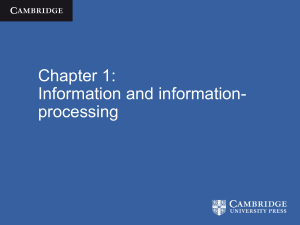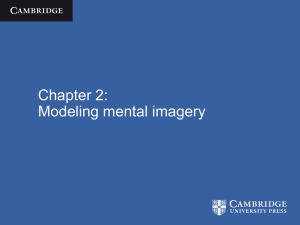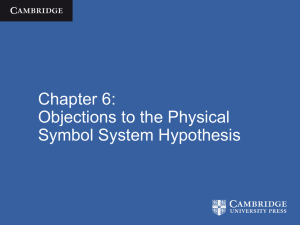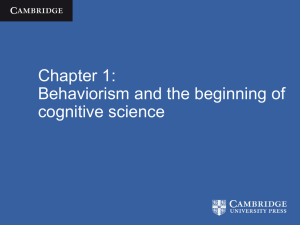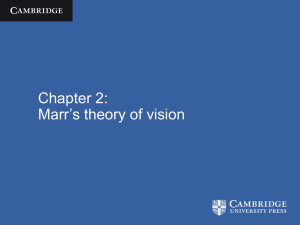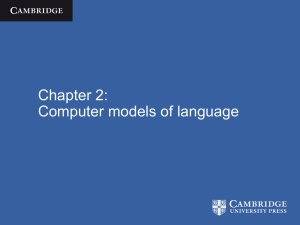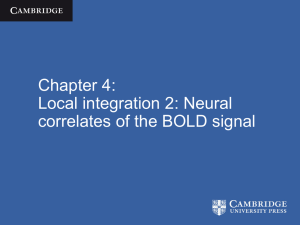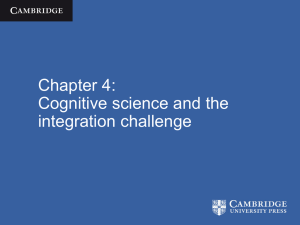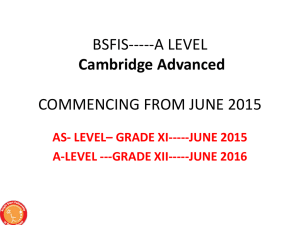Applying the PSSH
advertisement
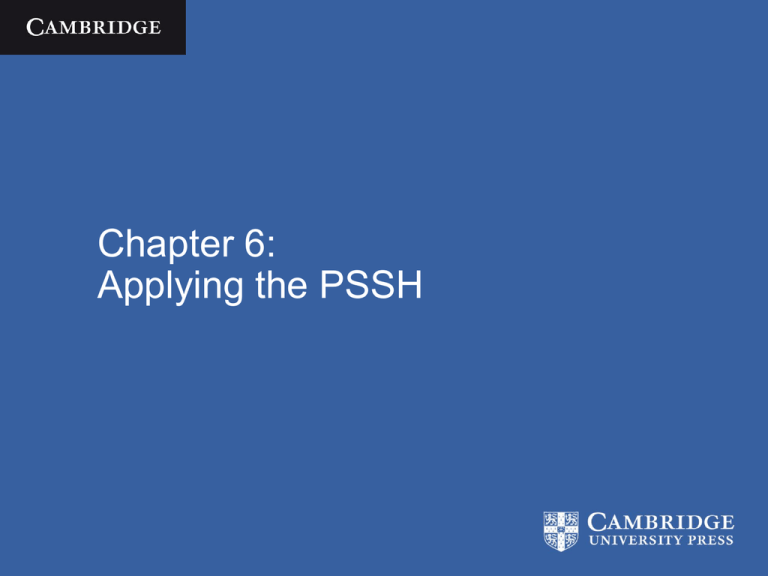
Chapter 6:
Applying the PSSH
Overview
• Explain why ID3 and SHAKEY both count as
illustrations of the heuristic search hypothesis
• Introduce frame problem
• Introduce background to the language of thought
hypothesis (as an application of the PSSH)
Cognitive Science
José Luis Bermúdez / Cambridge University Press 2010
ID3 and PSSH
• ID3 transforms one highly complex symbol
structure (database) into another (a decision
tree)
• The decision tree itself works by transforming
symbol structures according to rules
• Rules are the IF. . . THEN . . . rules built into the decision tree
Cognitive Science
José Luis Bermúdez / Cambridge University Press 2010
Heuristic search
• Problems are solved by generating and modifying
symbol structures until a solution structure is
reached
• Problem-spaces are generally too large to be
searched exhaustively (brute force algorithms)
• Search must be selective heuristic search rules
Cognitive Science
José Luis Bermúdez / Cambridge University Press 2010
ID3 as heuristic search
• ID3 is a tool for navigating through the search
space of decision trees
• The algorithm that it uses sorts through possible
decision trees using measures of information
gain and entropy reduction
Cognitive Science
José Luis Bermúdez / Cambridge University Press 2010
Basic concepts
Entropy – level of uncertainty (relative to a target attribute)
Information gain – reduction of entropy (relative to the
target attribute)
The algorithm compares different classifying attributes in
order to determine which has the highest information
gain
Cognitive Science
José Luis Bermúdez / Cambridge University Press 2010
SHAKEY and logic programming
Basic ideas
(1) states in state-spaces characterized by sets of
predicate calculus formulas
(2) problems are conjectures to be proved
(3) problem-solving is finding proofs using prooftheoretic techniques and heuristic search techniques
Cognitive Science
José Luis Bermúdez / Cambridge University Press 2010
Turn on the light switch
GO SHAKEY!
1. Goal wff =
STATUS (SWITCH1, ON)
2. STRIPS solution =
{goto2 (BOX1), climbonbox
(BOX 1),
Climboffbox (BOX 1)
Pushto (BOX 1, SWITCH 1)
Climbonbox (BOX 1)
Turnonlight (SWITCH 1)
Cognitive Science
José Luis Bermúdez / Cambridge University Press 2010
The frame problem
• Applying an operator to a state in a state-space problem
will affect some relations between objects in the state but
not others
• How is the system to keep track of which relations have
changed and which not?
• Proofs would be very complicated if there were axioms for
each operator specifying the relevant changes and nonchanges
Cognitive Science
José Luis Bermúdez / Cambridge University Press 2010
Possible framing
axiom:
(on C B) & (put B
table) (on C B)
Framing axiom?
Cognitive Science
José Luis Bermúdez / Cambridge University Press 2010
SHAKEY and the frame problem
SHAKEY has a limited solution to the frame problem built into it
The F-rules in STRIPS have three components
• Precondition formula
• Delete list
• Add formula
The Delete list makes explicit how the state description needs to
be altered
Cognitive Science
José Luis Bermúdez / Cambridge University Press 2010
Example
• Pickup (x)
• Precondition formula:
ONTABLE (x) & HANDEMPTY & CLEAR (x)
• Delete list:
{ONTABLE (x), HANDEMPTY, CLEAR (x)}
• Add formula:
HOLDING (x)
Cognitive Science
José Luis Bermúdez / Cambridge University Press 2010
Limitations of SHAKEY
• SHAKEY’s explicit solution to the frame problem
works only because the microworld is so
restricted
• Each operator will only have a small number of effects on the state
• These can be explicitly listed
• But this won’t scale up, when we introduce other
agents and a more complex environment
Cognitive Science
José Luis Bermúdez / Cambridge University Press 2010

